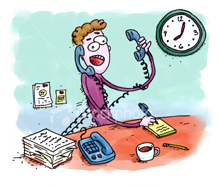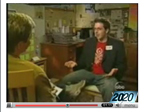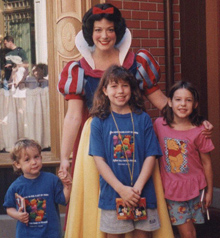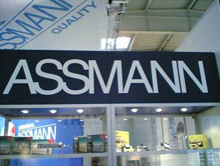 There are 55 strategies in my new book. Right now you are about to read what I believe is the best one. My fave. Numero uno.
There are 55 strategies in my new book. Right now you are about to read what I believe is the best one. My fave. Numero uno.
Ready?
It’s called a Daily Appointment with Yourself.
I’ve been practicing this technique every single day for five years, and I submit to you that it’s the most valuable habit I’ve ever developed.
Ever.
It all started in Portland. I moved there after college because 1) I didn’t know anybody, 2) I didn’t have a job and 3) I’d never been there before.
All good reasons to go, right?
Anyway, I got a job slingin’ couches at a discount furniture store (more on how much I hated this job later). Now, because it was retail, I knew the days would be long, stressful and trying on my patience. So I decided to start “prepping” myself mentally.
Across the street from my apartment on NW Irving was a place called Coffee Time. Every morning at about 7 AM, I grabbed a cup, found a comfortable chair and got myself situated. Then, for the next hour, I did a combination of the following things:
• Journaling my thoughts
• Reading positive, inspirational books
• Reviewing my goals and personal mission statement
• Meditating through breathing exercises
• Praying on the day, my concerns, etc.
• Emptying my mind of all things negative
• Practicing positive self-talk to develop a great attitude (ahem, chapter two)
By the time I finished my appointment, I felt revitalized, energetic, positive, enthusiastic, happy and ready to take on the day. I was mentally prepared to handle anything the world threw at me because.
That appointment laid the foundation.
I became addicted. I never missed a day. Even on the weekends. And no matter how busy, tired or stressed I was; there was nothing more critical to achieving daily success than my Daily Appointment. As a result, I developed an amazing attitude that began to attract success, happiness and yes, even money, into my life.
Then one day I overslept.
I think it was a Tuesday. I was running late and didn’t have time for my Daily Appointment.
So I skipped it.
BIG mistake.
I missed my bus, forgot to bring my iPod for the commute and ended up rushing to work about 20 minutes late.
I had a terrible day. First one in months. Everything went wrong. I screwed up orders. I snapped at customers. I was annoyed, upset, tired, frustrated and therefore, didn’t sell many couches.
Nine hours later I returned home from a day that felt like it would never end. And as I lay on my bed, I knew exactly where I went wrong.
Since then, I’ve only missed about a dozen daily appointments in five years.
That’s how powerful this habit is. It’s amazing. And I promise, if you start practicing it every single day:
o You will become less stressed
o You will have fewer bad days
o You will develop a more positive & attractive attitude
So, now that you’ve got that extra hour (providing you read the last chapter) here are a few guidelines for setting up your own Daily Appointment. Feel free to modify them to best fit your needs:
1. Solitude. No conversations. No distractions. You need alone time. If you choose to make your appointment at home, tell everyone else in the house that you’re not to be bothered. Treat it like a real appointment with someone very important. Turn off that damn cell phone.
2. Atmosphere. Music helps drown out the outside world and enables you to focus on clearing your mind. I suggest calm, soothing sounds. Headphones work best to really pump the tunes into your mind and help you focus.
3. Supplies. Depending on your routine, you’ll need journals, goal sheets, personal mission statements, positive reading material, headphones, pens, coffee and anything else you need to make this appointment the most comfortable.
4. Time. Before work. Before breakfast. Before working out. Before anything. Trust me, the earlier the better. You need to set the stage for your entire day.
5. Duration. There is no time requirement, although you can’t have much of a Daily Appointment in less than 15 minutes. In fact, a 1999 issue of Transactional Analysis Journal revealed that successful people spend at least 15 minutes every day thinking about how they can improve their lives. And if you think you don’t have that much time in a day, you’re wrong. You don’t have the time NOT to do this. Trust me, it’s worth every second.
6. Components. Although this part is really up to you, some key components include: reading something positive (that means NO newspapers), journaling your thoughts, reviewing goals (HUGE!), doing breathing exercises, practicing daily affirmations and of course, giving thanks. Other activities include praying, meditating, visualizing the success of your day, logging your dreams, etc. Feel free to personalize this appointment according to your needs.
Try it for a month. You WILL notice immediate changes.
Because there’s no appointment more important than the one you have with yourself.
Every day.
(To hear an awesome podcast with Jim Canterucci about this very topic, click here!)
LET ME ASK YA THIS…
What’s your favorite daily ritual?
LET ME SUGGEST THIS…
Share how that ritual has changed your daily life here!
 * * * *
* * * *
Scott Ginsberg
That Guy with the Nametag
Download Scott’s new book!
Right here, right now, for FREE, no strings.

 Seth had a
Seth had a  * * * *
* * * * Talking makes you think.
Talking makes you think. * * * *
* * * * Are you the luckiest person you know?
Are you the luckiest person you know? Brands are expectations.
Brands are expectations. * * * *
* * * * The cashier swiped my credit card.
The cashier swiped my credit card. * * * *
* * * * A few months ago, author, pastor (and my homeboy)
A few months ago, author, pastor (and my homeboy)  * * * *
* * * * Are you worried about The Competition?
Are you worried about The Competition? * * * *
* * * * I believe the following sentence is a myth:
I believe the following sentence is a myth: * * * *
* * * * Just finished my four-day stint here in South Flor-ee-da.
Just finished my four-day stint here in South Flor-ee-da. * * * *
* * * *